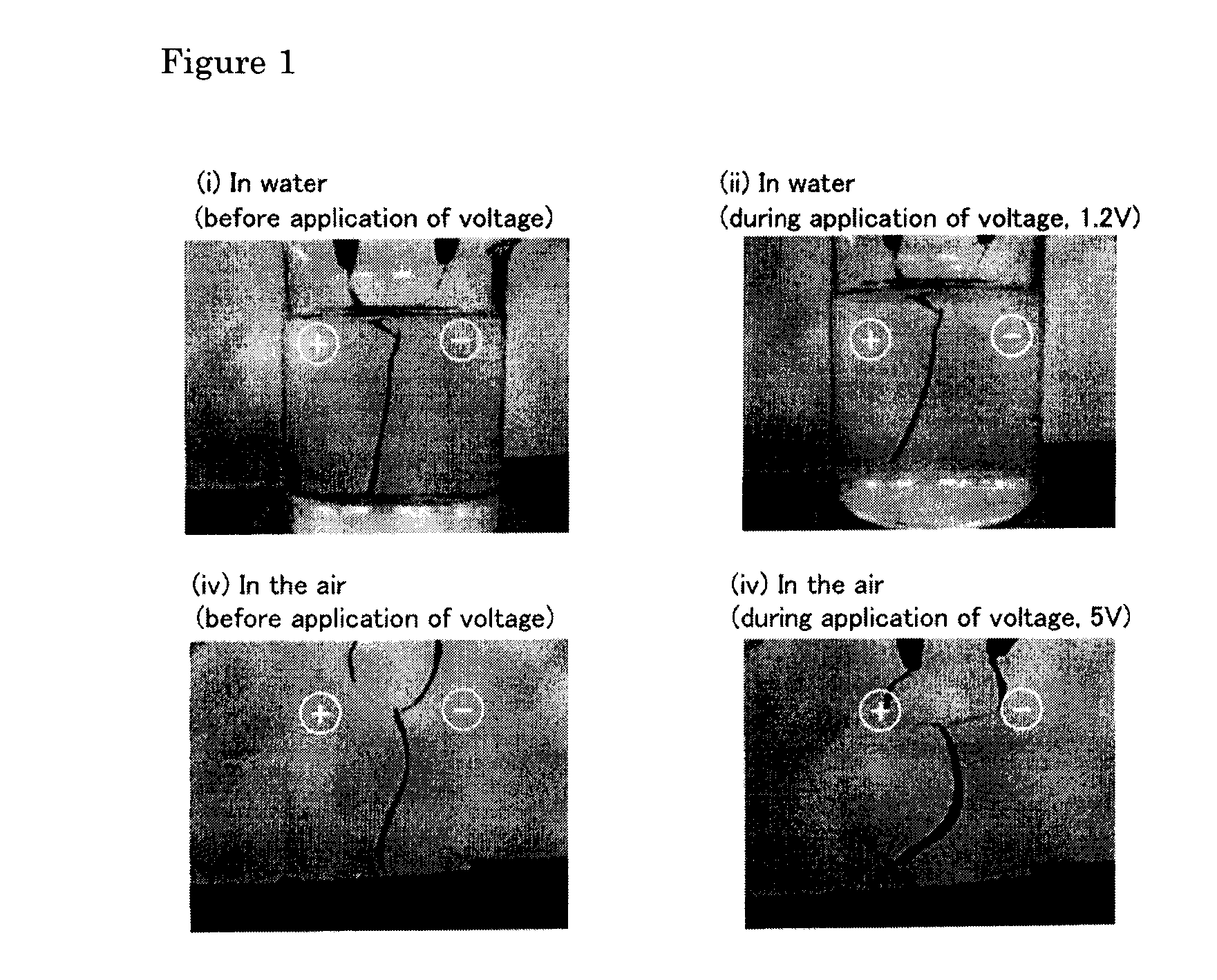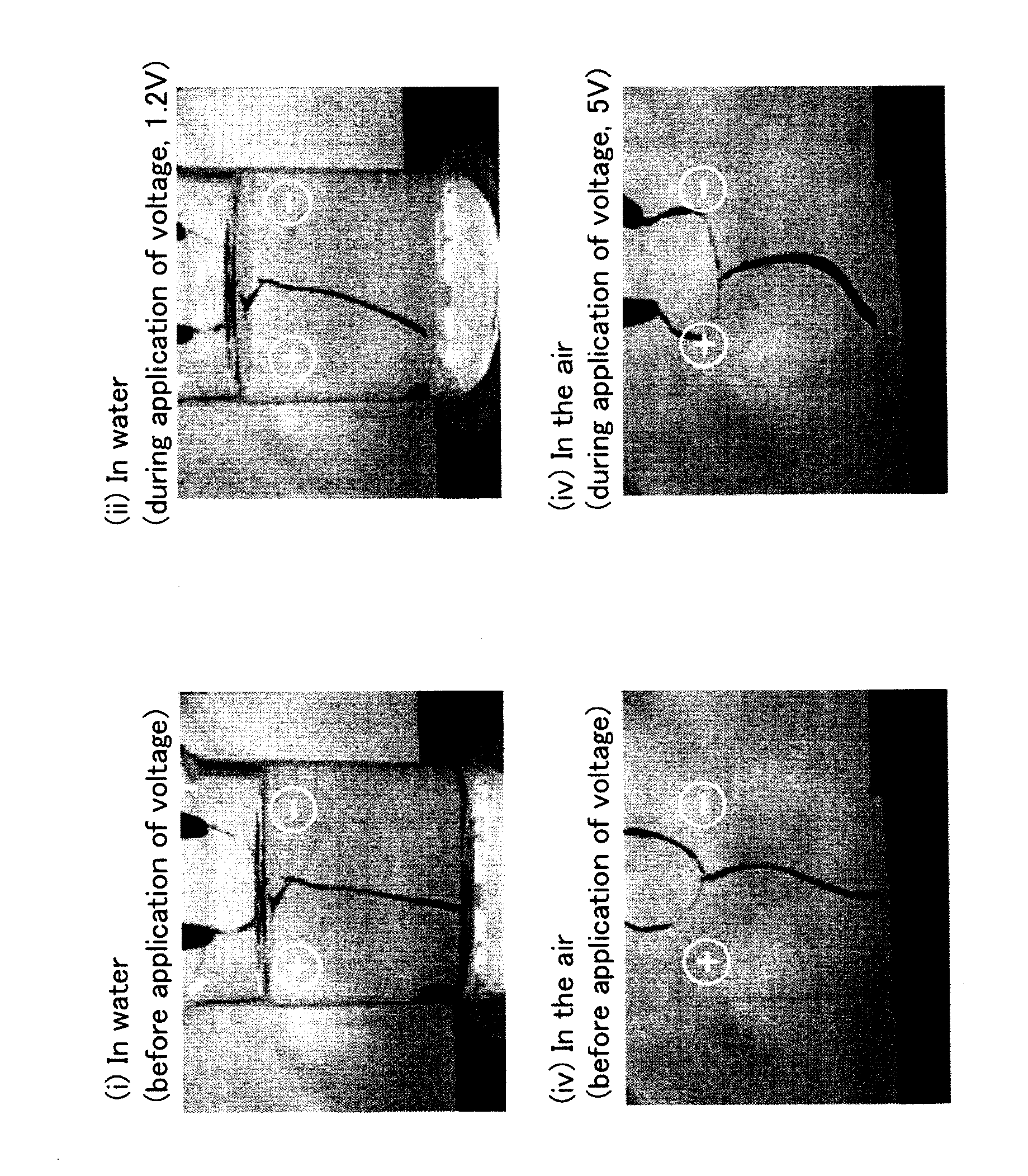Polymer electrochemical device
a polymer electrochemical and electrochemical technology, applied in the direction of fused electrolyte fuel cells, cell components, cell component details, etc., can solve the problems of inability to use microminiature machines as actuators, inability to soften and/or lighten, and inability to achieve microminiature machines with limited softening and/or lightening, etc., to achieve excellent flexibility and elongation, improve polymerization efficiency and ease of industrial economic efficiency
- Summary
- Abstract
- Description
- Claims
- Application Information
AI Technical Summary
Benefits of technology
Problems solved by technology
Method used
Image
Examples
referential example 1
Production of a Block Copolymer Composed of poly(α-methylstyrene) (Polymer Block (A)) and Hydrogenated Polybutadiene (Polymer Block (B))
[0111] In a similar process to a previously reported process (WO 02 / 40611), a poly(α-methylstyrene)-b-polybutadiene-b-poly(α-methylstyrene) triblock copolymer was synthesized. As to the resulting triblock copolymer, Mn and Mw / Mn of the poly(α-methylstyrene) part were 6,600 and 1.08, respectively, Mn and Mw / Mn of the whole copolymer were 80,590 and 1.07, respectively, and the amount of 1,4-bond and the content of α-methylstyrene unit in the polybutadiene part were 58.9% and 28.7% by mass, respectively. Further, it was revealed by composition analysis through 1H-NMR spectrum measurement that α-methylstyrene was substantially not copolymerized into the polybutadiene block.
[0112] The triblock copolymer obtained was dissolved in cyclohexane, the solution was put in a pressure proof vessel, the atmosphere of the vessel was replaced with nitrogen, hydrog...
referential example 2
Sulfonation of mSEBmS
[0113] 355 g of mSEBmS obtained in Referential example 1 was vacuum dried for 1 hour in a glass-made reaction vessel equipped with a stirrer, the inside atmosphere of the reaction vessel was replaced with nitrogen, 3 L of methylene chloride was added, and the mixture was stirred at 35° C. for 2 hours to dissolve mSEBmS. After the dissolution, a sulfonating reagent prepared by reacting 34.7 ml of acetic anhydride with 77.5 ml of sulfuric acid at 0° C. in 155 ml of methylene chloride was gradually added dropwise thereto over a period of 5 minutes. After stirring at 35° C. for 7 hour, the reaction solution was poured into 10 L of distilled water under stirring to coagulate and deposit a sulfonated mSEBmS. The deposited solid matter was washed with distilled water of 90° C. for 30 minutes, and then filtered. This operation of washing and filtration was repeated until the pH of the washings became unchanged, and the polymer after the final filtration was vacuum drie...
referential example 3
Sulfonation of polystyrene-b-poly(ethylene / butylene)-b-polystyrene
[0114] Similar operations as in Referential example 2 were conducted except that polystyrene-b-poly(ethylene / butylene)-b-polystyrene (“SEPTON 8007” made by KURARAY Co., Ltd., hereinafter abbreviated as SEBS) was used in place of mSEBmS, whereby a sulfonated SEBS was obtained. The sulfonation proportion of the benzene rings of the styrene units in the sulfonated SEBS was 48.5% by mol, and its ion exchange capacity was 1.21 meq / g.
[0115] The sulfonation proportions and ion exchange capacities of the sulfonated mSEBmS of Referential example 2, the sulfonated SEBS of Referential example 3 and the fluorine-type ion exchange resin membrane used in Referential example 8 hereinafter described are shown together in the following Table 1.
TABLE 1SulfonationIon exchangeproportion2)capacity(mol %)(meq / g)Sulfonated mSEBmS49.81.08Sulfonated SEBS48.51.21Nafion 1171)—0.91
1)Made by DuPont Co., tetrafluoroethylene-perfluoro(sulfonyle...
PUM
| Property | Measurement | Unit |
|---|---|---|
| voltage | aaaaa | aaaaa |
| softening point | aaaaa | aaaaa |
| temperature | aaaaa | aaaaa |
Abstract
Description
Claims
Application Information
 Login to View More
Login to View More - R&D
- Intellectual Property
- Life Sciences
- Materials
- Tech Scout
- Unparalleled Data Quality
- Higher Quality Content
- 60% Fewer Hallucinations
Browse by: Latest US Patents, China's latest patents, Technical Efficacy Thesaurus, Application Domain, Technology Topic, Popular Technical Reports.
© 2025 PatSnap. All rights reserved.Legal|Privacy policy|Modern Slavery Act Transparency Statement|Sitemap|About US| Contact US: help@patsnap.com



